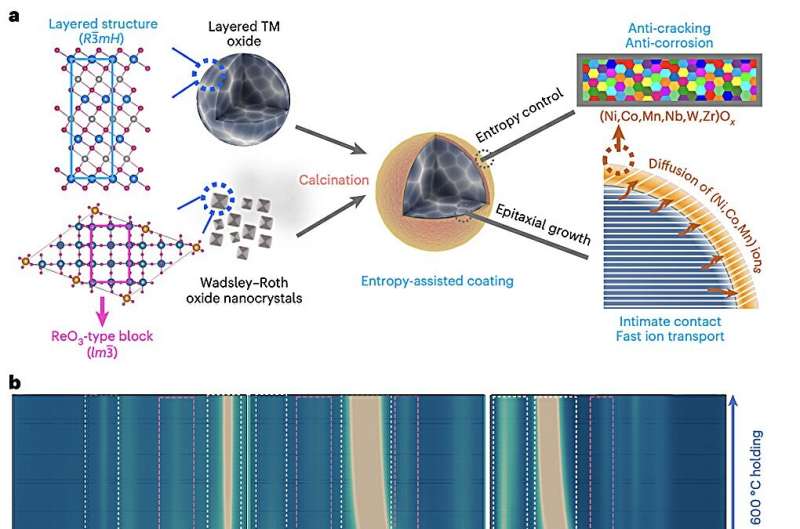March 25, 2024 feature
This article has been reviewed according to Science X's editorial process and policies. Editors have highlighted the following attributes while ensuring the content's credibility:
fact-checked
peer-reviewed publication
trusted source
proofread
A strategy to suppress strain propagation in ultrahigh-Ni cathodes during fast charging

To meet the growing demand of the electronics industry and support the widespread deployment of electric vehicles, researchers will need to develop increasingly advanced and highly performing battery technologies. A promising approach for boosting the performance of lithium-ion batteries (LiBs) entails the use of nickel (Ni)-rich layered oxides as cathode materials.
These Ni-rich cathodes can have numerous advantages, for instance increasing the capacity of batteries, improving their rate capabilities and lowering their overall fabrication costs. Nonetheless, studies so far have also highlighted their limitations, ranging from capacity degradation and structural instability during fast-charging and long-term cycling.
Researchers at Argonne National Laboratory and other institutes worldwide recently introduced a strategy that could improve the structural stability and reliability of ultrahigh-Ni cathodes. This strategy, outlined in a paper published in Nature Energy, entails the use of epitaxial entropy-assisted oxide coating to suppress strain propagation, the process that typically underpins the cathodes' structural deterioration during battery fast-charging and prolonged cycling.
"Surface reconstruction and the associated severe strain propagation have long been reported as the major cause of cathode failure during fast charging and long-term cycling," Chen Zhao, Chuanwei Wang and their collaborators wrote in their paper. "Despite tremendous attempts, no known strategies can simultaneously address the electro-chemomechanical instability without sacrificing energy and power density.
"We report an epitaxial entropy-assisted coating strategy for ultrahigh-Ni LiNixCoyMn1−x−yO2 (x ≥ 0.9) cathodes via an oriented attachment-driven reaction between Wadsley–Roth phase-based oxides and the layered-oxide cathodes."
Essentially, Zhao, Wang and their colleagues designed a specialized oxide coating that aligns with the structure of Ni-rich cathodes. In addition to enhancing the robustness of the cathode materials' surface, these coatings can enhance ionic conductivity, consequently supporting the fast charging of batteries.
The team's coating is based on Wadsley-Roth crystallographic shear phases, a class of compounds that have been found to boost the performance of electrodes in LiBs, Notably, these compounds were found to adhere better to Ni-rich cathodes, strengthening their structural stability during prolonged operation and fast-charging.
"The high anti-cracking and anti-corrosion tolerances as well as the fast ionic transport of the entropy-assisted surface effectively improved the fast charging/discharging capability, wide temperature tolerance and thermal stability of the ultrahigh-Ni cathodes," Zhao, Wang and their colleagues wrote.
"Comprehensive analysis from the primary and secondary particle level to the electrode level using multi-scale in situ synchrotron X-ray probes reveals greatly reduced lattice dislocations, anisotropic lattice strain and oxygen release as well as improved bulk/local structural stability, even when charging beyond the threshold state of charge (75%) of layered cathodes."
The researchers evaluated their proposed coating strategy in a series of experiments, where they coated Ni-rich layered cathodes and then tested their performance over time and under different conditions. Their findings were highly promising, as their approach significantly reduced damage to cathodes, even during fast-charging and after many operation cycles.
"We expect that such an epitaxial entropy-assisted coating strategy will open up surface engineering opportunities for the design and development of high-energy and high-power LiBs and beyond," the researchers concluded in their paper.
More information: Chen Zhao et al, Suppressing strain propagation in ultrahigh-Ni cathodes during fast charging via epitaxial entropy-assisted coating, Nature Energy (2024). DOI: 10.1038/s41560-024-01465-2
© 2024 Science X Network



















